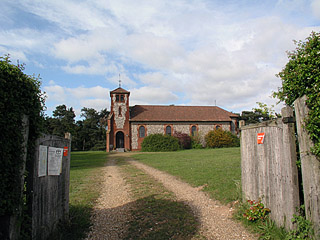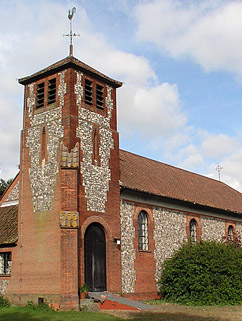What a glorious name for a village!
St George sits away from the village, past a level crossing and beyond several hedges. If one comes from the east, as we did, it seems to sit alone in the fields. Indeed, it seems almost to sit in a field, for the churchyard is large and only sparsely populated with graves.
The acre or so is surrounded by tall Scots pines: a nice hint of the Brecklands stretching away to the north east, towards Newmarket and Thetford Chase.
The church itself was built in 1935. It is quite a simple design: a hall, with a small sanctuary at the east end and a porch-tower in the south-west corner. I rather liked it, mostly for the unusual materials with which it’s built.
The nave is mostly built of (or at least faced with) flint, but on each of the north and south walls are vertical panels of very thin bricks, into which the windows are set. These have the look of Strawberry Hill gothic about them – perfectly round heads, but intersecting y-tracery of metalwork separating the panes.
The tower is also built of that combination of flint and brickwork, but with the proportions reversed: mostly the thin bricks, and above the south door a central panel of flint within the brickwork, with an undulating outline. In the middle is a small lancet, framed by more bricks.
Above that are the bell-openings, and the little pyramid roof curves out with a faintly oriental air. It’s quite fun, this church, and must be the only 1930s church in the county.
St George is locked, with no keyholders listed.

